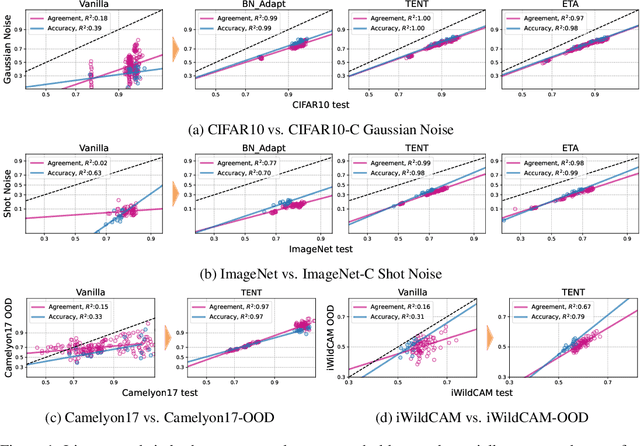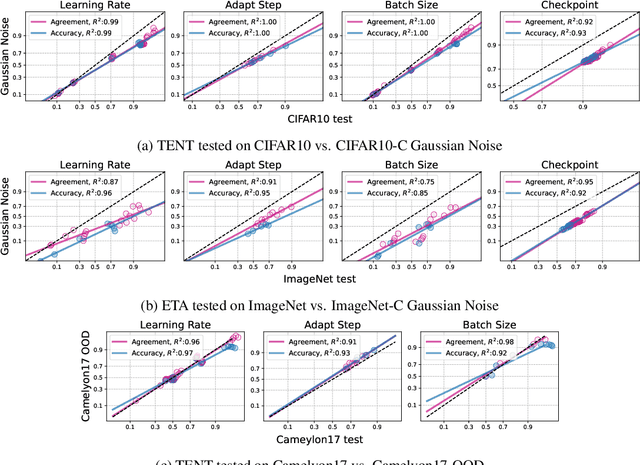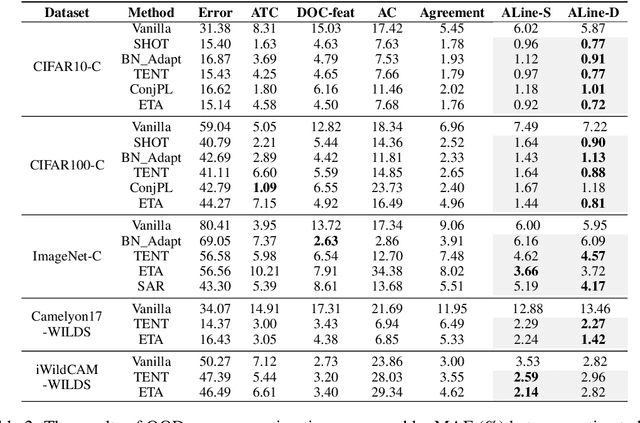Mingjie Sun
Command-V: Pasting LLM Behaviors via Activation Profiles
Jun 23, 2025Abstract:Retrofitting large language models (LLMs) with new behaviors typically requires full finetuning or distillation-costly steps that must be repeated for every architecture. In this work, we introduce Command-V, a backpropagation-free behavior transfer method that copies an existing residual activation adapter from a donor model and pastes its effect into a recipient model. Command-V profiles layer activations on a small prompt set, derives linear converters between corresponding layers, and applies the donor intervention in the recipient's activation space. This process does not require access to the original training data and needs minimal compute. In three case studies-safety-refusal enhancement, jailbreak facilitation, and automatic chain-of-thought reasoning--Command-V matches or exceeds the performance of direct finetuning while using orders of magnitude less compute. Our code and data are accessible at https://github.com/GithuBarry/Command-V/.
Noise-Consistent Siamese-Diffusion for Medical Image Synthesis and Segmentation
May 09, 2025Abstract:Deep learning has revolutionized medical image segmentation, yet its full potential remains constrained by the paucity of annotated datasets. While diffusion models have emerged as a promising approach for generating synthetic image-mask pairs to augment these datasets, they paradoxically suffer from the same data scarcity challenges they aim to mitigate. Traditional mask-only models frequently yield low-fidelity images due to their inability to adequately capture morphological intricacies, which can critically compromise the robustness and reliability of segmentation models. To alleviate this limitation, we introduce Siamese-Diffusion, a novel dual-component model comprising Mask-Diffusion and Image-Diffusion. During training, a Noise Consistency Loss is introduced between these components to enhance the morphological fidelity of Mask-Diffusion in the parameter space. During sampling, only Mask-Diffusion is used, ensuring diversity and scalability. Comprehensive experiments demonstrate the superiority of our method. Siamese-Diffusion boosts SANet's mDice and mIoU by 3.6% and 4.4% on the Polyps, while UNet improves by 1.52% and 1.64% on the ISIC2018. Code is available at GitHub.
ConSense: Continually Sensing Human Activity with WiFi via Growing and Picking
Feb 18, 2025Abstract:WiFi-based human activity recognition (HAR) holds significant application potential across various fields. To handle dynamic environments where new activities are continuously introduced, WiFi-based HAR systems must adapt by learning new concepts without forgetting previously learned ones. Furthermore, retaining knowledge from old activities by storing historical exemplar is impractical for WiFi-based HAR due to privacy concerns and limited storage capacity of edge devices. In this work, we propose ConSense, a lightweight and fast-adapted exemplar-free class incremental learning framework for WiFi-based HAR. The framework leverages the transformer architecture and involves dynamic model expansion and selective retraining to preserve previously learned knowledge while integrating new information. Specifically, during incremental sessions, small-scale trainable parameters that are trained specifically on the data of each task are added in the multi-head self-attention layer. In addition, a selective retraining strategy that dynamically adjusts the weights in multilayer perceptron based on the performance stability of neurons across tasks is used. Rather than training the entire model, the proposed strategies of dynamic model expansion and selective retraining reduce the overall computational load while balancing stability on previous tasks and plasticity on new tasks. Evaluation results on three public WiFi datasets demonstrate that ConSense not only outperforms several competitive approaches but also requires fewer parameters, highlighting its practical utility in class-incremental scenarios for HAR.
Idiosyncrasies in Large Language Models
Feb 17, 2025Abstract:In this work, we unveil and study idiosyncrasies in Large Language Models (LLMs) -- unique patterns in their outputs that can be used to distinguish the models. To do so, we consider a simple classification task: given a particular text output, the objective is to predict the source LLM that generates the text. We evaluate this synthetic task across various groups of LLMs and find that simply fine-tuning existing text embedding models on LLM-generated texts yields excellent classification accuracy. Notably, we achieve 97.1% accuracy on held-out validation data in the five-way classification problem involving ChatGPT, Claude, Grok, Gemini, and DeepSeek. Our further investigation reveals that these idiosyncrasies are rooted in word-level distributions. These patterns persist even when the texts are rewritten, translated, or summarized by an external LLM, suggesting that they are also encoded in the semantic content. Additionally, we leverage LLM as judges to generate detailed, open-ended descriptions of each model's idiosyncrasies. Finally, we discuss the broader implications of our findings, particularly for training on synthetic data and inferring model similarity. Code is available at https://github.com/locuslab/llm-idiosyncrasies.
Massive Values in Self-Attention Modules are the Key to Contextual Knowledge Understanding
Feb 03, 2025Abstract:Large language models (LLMs) have achieved remarkable success in contextual knowledge understanding. In this paper, we show that these concentrated massive values consistently emerge in specific regions of attention queries (Q) and keys (K) while not having such patterns in values (V) in various modern transformer-based LLMs (Q, K, and V mean the representations output by the query, key, and value layers respectively). Through extensive experiments, we further demonstrate that these massive values play a critical role in interpreting contextual knowledge (knowledge obtained from the current context window) rather than in retrieving parametric knowledge stored within the model's parameters. Our further investigation of quantization strategies reveals that ignoring these massive values leads to a pronounced drop in performance on tasks requiring rich contextual understanding, aligning with our analysis. Finally, we trace the emergence of concentrated massive values and find that such concentration is caused by Rotary Positional Encoding (RoPE), which has appeared since the first layers. These findings shed new light on how Q and K operate in LLMs and offer practical insights for model design and optimization. The Code is Available at https://github.com/MingyuJ666/Rope_with_LLM.
SweetTokenizer: Semantic-Aware Spatial-Temporal Tokenizer for Compact Visual Discretization
Dec 17, 2024



Abstract:This paper presents the \textbf{S}emantic-a\textbf{W}ar\textbf{E} spatial-t\textbf{E}mporal \textbf{T}okenizer (SweetTokenizer), a compact yet effective discretization approach for vision data. Our goal is to boost tokenizers' compression ratio while maintaining reconstruction fidelity in the VQ-VAE paradigm. Firstly, to obtain compact latent representations, we decouple images or videos into spatial-temporal dimensions, translating visual information into learnable querying spatial and temporal tokens through a \textbf{C}ross-attention \textbf{Q}uery \textbf{A}uto\textbf{E}ncoder (CQAE). Secondly, to complement visual information during compression, we quantize these tokens via a specialized codebook derived from off-the-shelf LLM embeddings to leverage the rich semantics from language modality. Finally, to enhance training stability and convergence, we also introduce a curriculum learning strategy, which proves critical for effective discrete visual representation learning. SweetTokenizer achieves comparable video reconstruction fidelity with only \textbf{25\%} of the tokens used in previous state-of-the-art video tokenizers, and boost video generation results by \textbf{32.9\%} w.r.t gFVD. When using the same token number, we significantly improves video and image reconstruction results by \textbf{57.1\%} w.r.t rFVD on UCF-101 and \textbf{37.2\%} w.r.t rFID on ImageNet-1K. Additionally, the compressed tokens are imbued with semantic information, enabling few-shot recognition capabilities powered by LLMs in downstream applications.
Bi-Mamba: Towards Accurate 1-Bit State Space Models
Nov 18, 2024Abstract:The typical selective state-space model (SSM) of Mamba addresses several limitations of Transformers, such as quadratic computational complexity with sequence length and significant inference-time memory requirements due to the key-value cache. However, the growing size of Mamba models continues to pose training and deployment challenges and raises environmental concerns due to considerable energy consumption. In this work, we introduce Bi-Mamba, a scalable and powerful 1-bit Mamba architecture designed for more efficient large language models with multiple sizes across 780M, 1.3B, and 2.7B. Bi-Mamba models are trained from scratch on data volume as regular LLM pertaining using an autoregressive distillation loss. Extensive experimental results on language modeling demonstrate that Bi-Mamba achieves performance comparable to its full-precision counterparts (e.g., FP16 or BF16) and much better accuracy than post-training-binarization (PTB) Mamba baselines, while significantly reducing memory footprint and energy consumption compared to the original Mamba model. Our study pioneers a new linear computational complexity LLM framework under low-bit representation and facilitates the future design of specialized hardware tailored for efficient 1-bit Mamba-based LLMs.
FBI-LLM: Scaling Up Fully Binarized LLMs from Scratch via Autoregressive Distillation
Jul 09, 2024



Abstract:This work presents a Fully BInarized Large Language Model (FBI-LLM), demonstrating for the first time how to train a large-scale binary language model from scratch (not the partial binary or ternary LLM like BitNet b1.58) to match the performance of its full-precision counterparts (e.g., FP16 or BF16) in transformer-based LLMs. It achieves this by employing an autoregressive distillation (AD) loss with maintaining equivalent model dimensions (130M, 1.3B, 7B) and training data volume as regular LLM pretraining, while delivering competitive results in terms of perplexity and task-specific effectiveness. Intriguingly, by analyzing the training trajectory, we find that the pretrained weight is not necessary for training binarized LLMs from scratch. This research encourages a new computational framework and may facilitate the future design of specialized hardware tailored for fully 1-bit LLMs. We make all models, code, and training dataset fully accessible and transparent to support further research (Code: https://github.com/LiqunMa/FBI-LLM. Model: https://huggingface.co/LiqunMa/).
Massive Activations in Large Language Models
Feb 27, 2024



Abstract:We observe an empirical phenomenon in Large Language Models (LLMs) -- very few activations exhibit significantly larger values than others (e.g., 100,000 times larger). We call them massive activations. First, we demonstrate the widespread existence of massive activations across various LLMs and characterize their locations. Second, we find their values largely stay constant regardless of the input, and they function as indispensable bias terms in LLMs. Third, these massive activations lead to the concentration of attention probabilities to their corresponding tokens, and further, implicit bias terms in the self-attention output. Last, we also study massive activations in Vision Transformers.
Reliable Test-Time Adaptation via Agreement-on-the-Line
Oct 07, 2023



Abstract:Test-time adaptation (TTA) methods aim to improve robustness to distribution shifts by adapting models using unlabeled data from the shifted test distribution. However, there remain unresolved challenges that undermine the reliability of TTA, which include difficulties in evaluating TTA performance, miscalibration after TTA, and unreliable hyperparameter tuning for adaptation. In this work, we make a notable and surprising observation that TTAed models strongly show the agreement-on-the-line phenomenon (Baek et al., 2022) across a wide range of distribution shifts. We find such linear trends occur consistently in a wide range of models adapted with various hyperparameters, and persist in distributions where the phenomenon fails to hold in vanilla models (i.e., before adaptation). We leverage these observations to make TTA methods more reliable in three perspectives: (i) estimating OOD accuracy (without labeled data) to determine when TTA helps and when it hurts, (ii) calibrating TTAed models without label information, and (iii) reliably determining hyperparameters for TTA without any labeled validation data. Through extensive experiments, we demonstrate that various TTA methods can be precisely evaluated, both in terms of their improvements and degradations. Moreover, our proposed methods on unsupervised calibration and hyperparameters tuning for TTA achieve results close to the ones assuming access to ground-truth labels, in terms of both OOD accuracy and calibration error.
 Add to Chrome
Add to Chrome Add to Firefox
Add to Firefox Add to Edge
Add to Edge